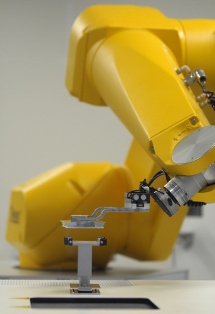|
Sanford Burnham's Innovative Approach to Drug Discovery Could Benefit Florida Research  There is a shift underway in the field of drug discovery. Big Pharma is stepping away from early clinical studies and that's leaving a lot of promising research with no clear forward path. But research entities in Central Florida are among those finding innovative ways to traverse what's known as the Valley of Death. [One of three robots running experiments at Sanford Burnham at Lake Nona] A robot whizzes as its giant arm pivots at the Sanford Burnham Medical Research Institute at Lake Nona. It’s nearly 6-feet tall, painted caution yellow and is imposing with its size, speed and finesse. It takes a little tray- maybe 3 by 4 inches and a quarter inch thick, and moves it from one location to another. The tray is divided into 1536 tiny wells, each well is its own experiment or petri dish. “You’re now, instead of reading one dish of cells, you’re reading 1536 dishes at the same time,” she says. For researchers like Mayo Clinic of Florida Associate Professor Pam McLean, that’s huge. McLean is investigating Parkinson’s disease and how it’s affected by changes in a protein called alpha synuclein. She’s hoping to hit on a drug therapy to prevent those changes. Her own lab’s capacity for running experiments has limits. But a new collaborative effort called the Florida Translational Research Program at Sanford Burnham gives researchers like McLean access to Sanford Burnham high through-put screens. Sanford Burnham has a library of hundreds of thousands of chemical compounds and three robots that can run up to a million experiments per day. By running her experiments at Sanford Burnham, Mclean will learn fairly quickly whether she’s on the path to a drug therapy for Parkinson’s. In fact, preliminary results are expected this spring. “In this kind of research you want to fail fast,” says Layton Smith, Sanford Burnham Florida’s Drug Discovery Director. He says once Sanford Burnham was established in Florida, it became clear the lab had enough capacity to share its research space. “Once we realized we could leverage this excess capacity, we began formulating an idea and asking ourselves how could we get more scientists involved in therapeutic discovery. And that’s what led us to the Florida legislature to talk about funding the Florida Translational Research Program,” he says. Traditionally, scientists would need funding to take their lab research to a facility like Sanford Burnham, where there’s a chance to get a hit on a promising drug compound. If that happens- the potential therapy would go through animal testing and then human clinical trials. The process of advancing discoveries from the laboratory to drug development- which can cost more than a billion dollars- is called the Valley of Death- the risk of failure is huge- big enough that pharmaceutical companies are becoming less and less interested in early stage drug discovery. But collaborations like the Florida Translational Research Program are changing things. Pam McLean says access to Sanford Burnham is speeding her research and helping her budget. “There is a cost-saving for me because we have been able to secure funds from the state of Florida which is actually paying to have the screens done at Sanford Burnham,” she says. Florida Department of Health Public Health Research Unit Manager Robert Hood says the state’s interest in supporting collaborative research, particularly cancer research, will ultimately have an impact on healthcare in Florida. “I’m excited about the initiatives that I’m able to support here, the grants that we make to individual researchers are based on rigorous peer review with the highest standards,” he says. Biotech research can mean more clinical trials, which Dr. Hood says is sometimes the only hope for cancer patients. Collaborative cancer research in Florida is funded with tobacco settlement money- but for other diseases, non-profits are now stepping up with funding for collaborative research that leads to drug discovery. The Michael J Fox Foundation for Parkinson’s Research and the Cystic Fibrosis Foundation are two examples. But the path being followed by Florida and Sanford Burnham is a little different. Sanford Burnham- a non-profit- isn’t providing funding- it’s giving Florida researchers access to its state of the art labs. “You know, one of the things that’s unique about this program is allows us to partner not only with universities and research institutes, but to serve as the unifier or a node in the network of science, in which we can connect our clinical partners with our basic science research partners with our corporate partners,” says Smith. And that might help Florida researchers make it through the Valley of Death. |
|
|